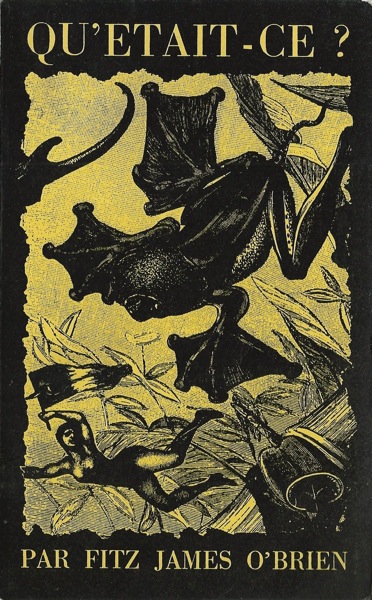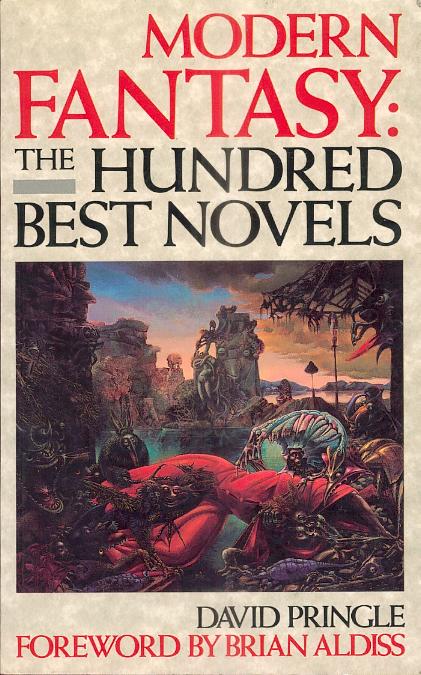Max Ernst (1891-1976) has long been one of my favorite artists. I had no idea, until browsing through the Penguin SF cover images from the 60s, that his art appeared on a variety of SF/F novels and related literature/nonfiction…. Yes, I had seen the memorable cover for J. G. Ballard’s The Crystal World (1966) [below] but I had not put the two together.
My favorite is without a doubt the use of Ernst’s awe-inspiring Europe After the Rain II (1940-42) for J. G. Ballard’s collection of stories, Memories of the Space Age (1988). The malaise generated by his landscapes of decay combined with the sheer power of Ballard’s visions evoke are almost palpable shudders of joy…
There are a handful more but I have included most of the 50s to early 80s examples.
And today, April 2nd, is Max Ernst’s birthday! So, share, if you are so inclined, your favorite of his works of art. And, feel free to identify any that might appear on the covers below… Too bad more publishers don’t latch onto the joy that are his collages (do a google search and you will understand).
Enjoy!
(Max Ernst, Europe After the Rain, cover for the 1988 edition of J. G. Ballard’s Memories of the Space Age, 1988)
(Max Ernst’s cover for the 1963 edition of James Blish’s A Case of Conscience, 1958)
(Max Ernst’s cover for the 1968 edition—although it was used on the 1966 edition as well—of J. G. Ballard’s The Crystal World, 1966)
(Max Ernst’s cover for the 1974 edition of Aldous Huxley’s The Doors of Perception and Heaven and Hell, 1959)
(Max Ernst’s cover for the 1977 edition of Stanislaw Lem’s Mortal Engines, 1977)
(Max Ernst’s 1963 cover for the edition of Eric Frank Russell’s Three to Conquer, 1955)
(Max Ernst’s 1965 cover for Philip K. Dick’s The Man in the High Castle, 1962)
(Max Ernst’s cover for the 1950 edition of Fitz-James O’Brien’s Qu’était-ce?, 1950)
(Max Ernst’s 1963 cover for The Day it Rained Forever, Ray Bradbury, 1959)
(Max Ernst’s cover for the 1988 edition of David Pringle’s Modern Fantasy: The Hundred Best Novels, 1988)
For more adventures in SF cover art consult the INDEX











Fabulous! Thanks for sharing these!
Any favorites? 🙂
Europe after the Rain is always stunning.
great list
You’re welcome. What’s your favorite?
stanislaw lem !
Ballard’s obsession with Surrealism makes Ernst a perfect fit for his work. The more widespread use of it probably speaks to the explosion in pop interest in surrealism in the 1960s.
One of my fave Ernst’s is an early, 1920 Dada collage, ‘Murdering airplanes’:

That is lovely…. One of the best exhibits I’ve every been to was in Chicago a few years ago — it was a vast collection of small pieces of art (some done collectively) some independently by various Dada artists and Parisian figures….
It would be great to see more of them in the “flesh” as it were. Do you know if the Chicago Surrealist group around Penelope and Franklin Rosemont had anything to do with the exhibition?
That I do not know. It was 3 or 4 years ago…
J.G. Ballard’s writing,as you obviously know,was influenced by the inner states depicted by the Surrealists paintings,including Ernst,so the covers couldn’t be more representitive of his books,The surrealistic tone of “The Man in the High Castle”,is also reflected clearly by the brooding cover.
The haunting art of Powers and Lehr,shows the definite influence of Ernst,while Powers also appears to have been inspired by Tanguy.
Yeah, in one of my Powers art posts I put Tanguy and his work side-by-side. But yes, Ballard’s themes fit perfectly with Ernst’s work.
The melancholy paintings of Giorgio De Chirico were a forerunner of the Surrealist movement,and seemed to evoke the angst and loneliness of the twentieth century that Ballard and other modern SF were obviously aware of in their writings.He was also an immediate influence on another famous Surrealist painter,Rene Magritte.
Both their paintings would have seemed suitable for SF book covers,assuming they never have.
De Chirico’s work, particularly in the 1910s and 20s, is simply stunning. His influence was immense as you can see in some of the early work of the Surrealists. His strange, melancholia city scapes were also an important influence on the Letterist and Situationist Internationals in the 1950s and 60s.
Interestingly De Chirico also participated in Breton’s Surrealist group in the 1920s. Sadly his future trajectory was a bit miserable.
You should check out some of Carlo Carra’s work. He was initially attached to the futurists in the 1910s but came under the influence of De Chirico’ “metaphysical art”.
https://encrypted-tbn2.gstatic.com/images?q=tbn:ANd9GcTOl-lN4_UToxT9kCUAbXs6lrVs6ruAXGouX2DEXdaiJ_LKaQMKAw
I feel like I’ve seen quite a few of Carlo Carra’s paintings at The Pompidou center in Paris — went quite a few times when I was in the city for research for a few summesr…
Me too when I was in Paris a few years back for research (2013)! Spooky…
I was there that year! And last summer.
What are you researching? Is it sf related? I was in Paris so I could get access to the BnF, plus a trip up to the Institute for Social History in Amsterdam. I writing my thesis on l’internationale situationniste.
Definitely not SF related. I’m a medievalist. I spent my days in the BnF Richelieu (where the medieval manuscripts are) and the Bibliothèque Mazarine…
As for who I am, and what I study more specifically, you’re welcome to email me…. 😉 [ciceroplatobooks (at) gmail (dot) com]
OR, message me on twitter.
I want to keep my site pseudonymous.
I lived around the corner from the BnF Richelieu when I was in Paris. It’s also the locale of one of my favourite modern French writers Isidore Ducasse (aka Lautreamont). Have you seen the cool Alain Resnais short on the BnF Richelieu? https://www.youtube.com/watch?v=i0RVSZ_yDjs
It’s a nice area for sure — I love all the passages… I lived one year in the 13th (near Chinatown) and another in the 10th (i.e. where all the amazing Indian, Ethiopian, etc food is).
No I have not, thanks!
There are a few Magritte paintings for covers…
But no De Chirico paintings for covers (at least credited) until the 1990s… I do own a copy of this book. But it’s not SF or F.
Fantastic novel!
But yes, I enjoy all three artists.
There’s a cool film adaption of Buzzati’s novel from the 70s called The Desert of the Tartars.
Definitely! I saw it first before I knew about the book…. It’s great.
I actually have a review of the film on my site–when I wrote about film… and it was 6 years ago, so it’s not that great of a review.
https://sciencefictionruminations.wordpress.com/2010/07/18/490/
I saw the film a few years back too. More recently I worked out it was based on a novel and the novel now sits on my to read pile!
However a novel I have read, which I am sure you would love and what’s more has been compared to Buzzati’s is Julien Gracq’s Le Rivage des Syrtes (translated as The Opposing Shore). It’s a great work. If you haven’t read it find a copy, you won’t be sorry.
Yeah, I have not heard of that one. Thanks!
And Paul Klee…
The first time I saw that Three to Conquer cover, I thought it was so strange. I used it in my post about the book. Seeing it alongside that Bradbury puts it in better perspective as a series. I guess flowers in cracks must have been an Ernst phase in 1963.
That is probably my least favorite… It is such a strange cover. And the murky colors probably don’t do it justice.
I’m pretty sure I captioned it with some snarky remark in my own post.
What a fabulous collection of covers – many would grace the walls of any art gallery… My favourite is the Aldous Huxley cover. Superb colour, beautiful sweeping form and awesome overlaying of one image over the other. I would LOVE to have that on my wall:)
Interesting seeing the use of these works as Sci-Fi covers. Makes me wonder who else may have had their work used like this. Francis Bacon would seem to be a good fit, especially for Ballard.
Powers did say that Tanguay was a major influence.
Tanguy was used on some Penguin covers… this one for example. But, does not match the feel of Clement for sure! Alas.
And Picasso…
He made this work as cover for Minotaur; the
surrealists astonishing magazine from the thirties
And Kandinsky…
(In short, Penguin under the art direction of Germano Facetti pulled a lot surrealist art for their covers)
Here you go, Tanguy on a Ballard novel 🙂
New York Review of Books Classics has been using some of the surrealists for their covers, especially Soviet and Eastern European Sci-Fi.
A book came out a few years agi on the history of Penguin, I should find it.
Ernst’s art captures the ‘strange’ quality of 60’s and New Age SF that seems to have been replaced with more cuddly “worn out human-centric worlds” concepts.
I do think Ernst and 60s/70s SF goes well together! Although, most of the covers I supplied don’t really fit the feel of the contents (other than the Ballard). For example, in the comments above I posted a Tanguy cover for a Clement novel! Clement is “cuddly” and “bland.”
Late to the party (as usual): I like the covers for Lem and the edited book by Pringle. Here’s an interesting cover that I have in my current collection (though I haven’t been able to figure out the illustrator):
No problem! The answer to your question — Paul Bacon!
http://www.isfdb.org/cgi-bin/pl.cgi?270285
I highly highly highly recommend using The Internet Speculative Fiction Database to find artists, publication histories, etc. It is not complete but people constantly add to it — so it’ll only get better.
Thanks, JB!
Missed this post first time round, so delighted to find it. Max Ernst and SF go well together.
I missed your comment the first time around (my apologies). But yes, there is something about his art that fits well with SF from this era… especially Ballard.
Hello again! Have You read the novel Hebdomeros by Gorgio de Chirico? I think Brian Aldiss are mention it in Billion Year Spree. A visionary masterpiece!
Addenda: Written in french
Addenda II: Your site are of a very high class and very interesting, I really must admit!
/Mats, Sweden
Thank you for the kind words! I had not heard of Hebdoremos. Did you enjoy it? I’ve read some surrealist fiction over the years — most recently some Leonora Carrington short stories and The Trumpets of Jericho by Unica Zürn.
Yes a masterpiece with no ordinary plot (of course!). But visions upon vision, so to say. Published in 29 i think . The surrealists loved this novel but hated his art from this period. Personally i think it is written earlier but published 29. (His brother Alberto Savinio debutated around 1914) .
These brothers lived in small hotel rooms in Paris at this time (together with their mother!).
Errata: “I believe” not “I think” and “His younger brother Alberto Savinio (Andreas de Chirico), made his debut as writer …”
Well…